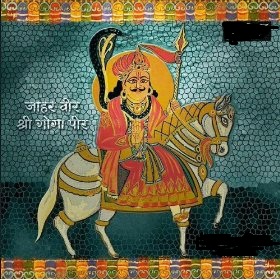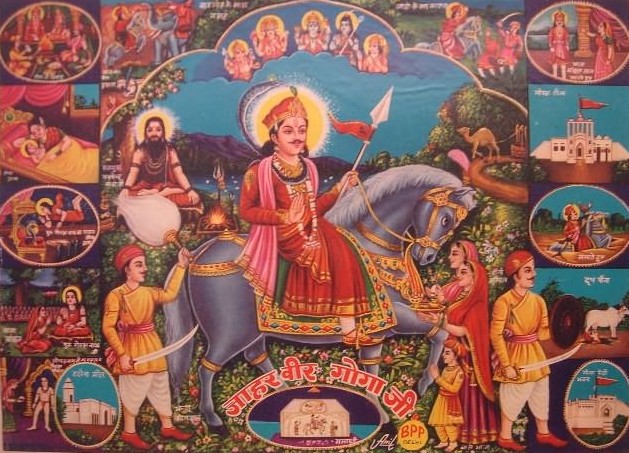Chhapar Mela on:
[Wikipedia]
[Google]
[Amazon]

 Chhapar Mela is celebrated in the village of Chhapar in the district of
Chhapar Mela is celebrated in the village of Chhapar in the district of

 Chhapar Mela is celebrated in the village of Chhapar in the district of
Chhapar Mela is celebrated in the village of Chhapar in the district of Ludhiana
Ludhiana ( ) is the most populous and the largest city in the Indian state of Punjab. The city has an estimated population of 1,618,879 2011 census and distributed over , making Ludhiana the most densely populated urban centre in the state. I ...
, Punjab
Punjab (; Punjabi: پنجاب ; ਪੰਜਾਬ ; ; also romanised as ''Panjāb'' or ''Panj-Āb'') is a geopolitical, cultural, and historical region in South Asia, specifically in the northern part of the Indian subcontinent, comprising a ...
, India every year in September. This mela (fair), held in the memory of Gugga
Gogaji (also known as Goga, Jahar Veer Gogga, Gugga, Gugga Pir, Gugga Jaharpir, Gugga Chohan, Gugga Rana, Gugga Bir and Raja Mandlik) is a folk deity, worshipped in the northern states of India especially in Rajasthan, Himachal Pradesh, Har ...
is one of the most popular and spectacular festivals of the Malwa belt of Punjab.
This three day fair commemorates the descent of the Gugga Veer, a Chauhan Rajput
Rajput (from Sanskrit ''raja-putra'' 'son of a king') is a large multi-component cluster of castes, kin bodies, and local groups, sharing social status and ideology of genealogical descent originating from the Indian subcontinent. The term Ra ...
, into the bosom of mother Earth along with his steed.
According to the legend, he obsessed extraordinary powers over all kinds of snakes. The fair is celebrated at Gugge di Marhi, a big holy place built in his memory that has a reputation for curing people of snake bites. Earth is scooped up seven times to appeal to Gugga Veer for safety against snakes.
People sing folk songs and present folk dances. The fair is held on the Anant Chaturdashi
Anant Chaturdashi / Ganesh Visarjan is a festival observed and celebrated by Hindus and Jains. Anant Chaturdashi is the last day of the ten-day-long Ganeshotsav or Ganesh Chaturthi festival and is also called Ganesh Chaudas when devotees bid adieu ...
on the 14th day of bright half of the Bhadon
Bhādõ ( pa, ਭਾਦੋਂ, ) is the sixth month of the Nanakshahi calendar and Punjabi calendar. This month coincides with Bhadra in the Hindu calendar and the Indian national calendar, and August and September in the Gregorian and Julian c ...
(mid August- midSeptember as per Hindu calendar
The Hindu calendar, Panchanga () or Panjika is one of various lunisolar calendars that are traditionally used in the Indian subcontinent and Southeast Asia, with further regional variations for social and Hindu religious purposes. They adopt a ...
).
People mainly worship the snake embodiment of Gugga
Gogaji (also known as Goga, Jahar Veer Gogga, Gugga, Gugga Pir, Gugga Jaharpir, Gugga Chohan, Gugga Rana, Gugga Bir and Raja Mandlik) is a folk deity, worshipped in the northern states of India especially in Rajasthan, Himachal Pradesh, Har ...
at this fair. The fair falls on the fourteenth day of Shukla Paksha
Paksha (also known as ''pakṣa''; sa, पक्ष, Nepal Bhasa: ''thwa'' and ''gа̄''; ) refers to a fortnight or a lunar phase in a month of the Hindu lunar calendar.
Literally meaning "side", a paksha is the period either side of the Ful ...
of the month of Bhadrapad
Bhadra or Bhadrapada or Bhādo or Bhadraba
(Bengali language, Bengali: ভাদ্র ''bhādro''; )
(Hindi: भादों ''bhādo''; )(Sanskrit: भाद्रपद ''bhādrapada'';) ( ne, भाद्र ''Bhādra'';) ( or, ଭାଦ୍� ...
every year. It is believed that, the Chhapar Fair was started around 150 years ago by a small congregation of devotees. In recent years the number of people attending the fair has risen to millions.
The Minor Chhapar Mela is also held at the same place. The special trend of scooping the land (seven times) is also practised in this fair. People consider digging of land will bring Gugga
Gogaji (also known as Goga, Jahar Veer Gogga, Gugga, Gugga Pir, Gugga Jaharpir, Gugga Chohan, Gugga Rana, Gugga Bir and Raja Mandlik) is a folk deity, worshipped in the northern states of India especially in Rajasthan, Himachal Pradesh, Har ...
Veer to protect them against snakes. The fair has much music, fun and dance. The fair has emerged as a grand festival in the past few decades.
The legend narrates the story of a boy and a snake born together in an agricultural family of Chhapar village. The serpent and the boy were so intimate that if one suffered a pain the other used to cry. One day the mother of the child went to the fields after laying him on a cot. To save him from the scorching sun, the snake stretched its hood over him. Thinking that the snake was going to bite the child, a passerby killed it with a stick. The child died immediately after the death of the snake and the family was left in sorrow. The family was advised by the elders to perform religious ceremonies to worship Gugga
Gogaji (also known as Goga, Jahar Veer Gogga, Gugga, Gugga Pir, Gugga Jaharpir, Gugga Chohan, Gugga Rana, Gugga Bir and Raja Mandlik) is a folk deity, worshipped in the northern states of India especially in Rajasthan, Himachal Pradesh, Har ...
and Siddha
''Siddha'' (Sanskrit: '; "perfected one") is a term that is used widely in Indian religions and culture. It means "one who is accomplished." It refers to perfected masters who have achieved a high degree of physical as well as spiritual ...
and a he-goat
The goat or domestic goat (''Capra hircus'') is a domesticated species of goat-antelope typically kept as livestock. It was domesticated from the wild goat (''C. aegagrus'') of Southwest Asia and Eastern Europe. The goat is a member of the a ...
was left free to mark the place of worship by striking at a particular place. The place was recognised as Mari Gugga
Gogaji (also known as Goga, Jahar Veer Gogga, Gugga, Gugga Pir, Gugga Jaharpir, Gugga Chohan, Gugga Rana, Gugga Bir and Raja Mandlik) is a folk deity, worshipped in the northern states of India especially in Rajasthan, Himachal Pradesh, Har ...
where people from all walks of life have been worshipping Gugga on the fourteenth day of bright half of the month of Bhadon every year. The farmers of the Malwa
Malwa is a historical region of west-central India occupying a plateau of volcanic origin. Geologically, the Malwa Plateau generally refers to the volcanic upland north of the Vindhya Range. Politically and administratively, it is also syn ...
belt recognise the fair to the extent that they change the agricultural chores according to the dates of the mela.
People also narrate another story regarding the second fair known as Minor Chhapar Mela. At the beginning of the 20th century, the Maharaja
Mahārāja (; also spelled Maharajah, Maharaj) is a Sanskrit title for a "great ruler", "great king" or " high king".
A few ruled states informally called empires, including ruler raja Sri Gupta, founder of the ancient Indian Gupta Empire, a ...
was said to have banned the Mela because of a complaint by some farmers. But soon after the ruler banned the event, his horses started dying mysteriously and the misfortune stopped only after the ruler announced plans to organise the Minor Mela following the major one.
According to another story, a faqir Faqir may refer to:
People
* Fakir, Sufi Muslim ascetics
* Faqir (given name), Arabic masculine name
* Faqir (clan), Muslim ethnic group in South Asia
Places
* Faqir Mosque
Faqir Mosque ( bn, ফকির মসজিদ, ar, ) is an obl ...
once anchored a twig after cleaning his teeth. A local person uprooted the twig in fun. The faqir then cursed the people of the local area so that the place would witness a heavy camp here, which would be followed by a deserted look.
References
External links
* http://www.unp.me/f16/mela-chappar-da-17681/#ixzz2ht86Xp00 {{Punjab, India Ludhiana district Punjabi culture Punjabi festivals Punjabi folk religion